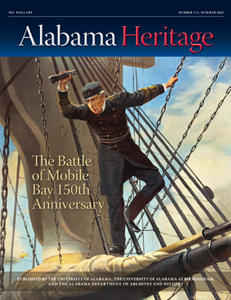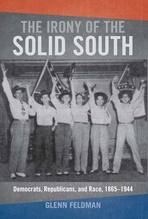|
On the cover: Admiral Farragut had himself lashed to the rigging at the Battle of Mobile Bay. (Library of Congress)
|
FEATURE ABSTRACTS
Defeat at Fort Bowyer: The Failed British Campaign for the Gulf Coast during the War of 1812
By Gene Allen Smith
By Gene Allen Smith
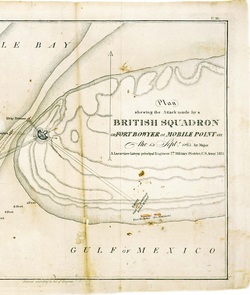 This map shows the position of British land
This map shows the position of British land forces, listed as 600 Indians and 150 marines,
and the movement of the four British ships.
(Historic New Orleans Collection, acc. No.
1979.238.1)
One inciting factor of the War of 1812 was the issue of impressment, in which British soldiers claimed the right to board foreign ships and claim their personnel for the British military. Given this, American forces in the Gulf of Mobile were perhaps especially pleased by their victory over the British Navy. The British hoped to take Mobile, a crucial port in the Gulf Coast, but troops stood strong against the siege, even managing to sink a British warship—the only time during the whole war that this happened. By protecting the American position at Mobile’s Fort Bowyer, these men helped ensure a victory in the War of 1812.
Additional Information
For more information about British involvement in the War of 1812, see The U.S. Naval Institute’s article here: http://www.usni.org/
About the Author
Gene Allen Smith, a native of Albertville, is a professor of history at Texas Christian University, in Fort Worth. During the 2013–2014 academic year, he served as the “Class of 1957 Distinguished Chair in Naval Heritage” at the US Naval Academy. He is author or editor of eight books and numerous articles and reviews on the War of 1812, naval and maritime history, and territorial expansion along the Gulf of Mexico. His most recent book is The Slaves’ Gamble: Choosing Sides in the War of 1812 (Palgrave, 2013).
Additional Information
For more information about British involvement in the War of 1812, see The U.S. Naval Institute’s article here: http://www.usni.org/
About the Author
Gene Allen Smith, a native of Albertville, is a professor of history at Texas Christian University, in Fort Worth. During the 2013–2014 academic year, he served as the “Class of 1957 Distinguished Chair in Naval Heritage” at the US Naval Academy. He is author or editor of eight books and numerous articles and reviews on the War of 1812, naval and maritime history, and territorial expansion along the Gulf of Mexico. His most recent book is The Slaves’ Gamble: Choosing Sides in the War of 1812 (Palgrave, 2013).
From Roosevelt to Rosa Parks: The Subversive World of Clifford and Virginia Durr, 1940 to 1955
By Thomas E. Reidy
By Thomas E. Reidy
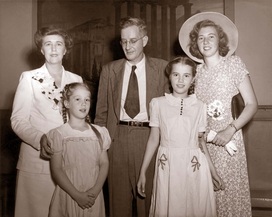 Cliff and Virginia with daughters Tilla, Lucy, and
Cliff and Virginia with daughters Tilla, Lucy, and Ann. The Durrs had one more daughter, Lulah,
late in life. Their only son died in infancy.
(Alabama Department of Archives and History)
After participating in writing the script for an Alabama Public Television film on Clifford and Virginia Durr, the author realized that a great deal of compelling information about the couple’s life and activism remained untold. Here, he focuses on the fifteen-year span that saw the Durrs move from Washington, DC, to Alabama. In this time, Cliff Durr went from holding prominent government positions that enabled him to work with presidents to a less visible—but equally crucial—legal practice defending civil rights cases throughout Alabama.
About the Author
Thomas E. Reidy is a Huntsville resident who has written several articles for Alabama Heritage. His most recent contribution was “Awaiting Justice: The Improbable Pardon of ‘Scottsboro Boy’ Clarence Norris” (Summer 2012). The article helped launch efforts that led to legislation allowing the state of Alabama to posthumously pardon all the Scottsboro defendants. Reidy teaches part-time at the University of Alabama in Huntsville and is currently writing a book on antebellum professionals. He graduated with a PhD in history from the University of Alabama.
About the Author
Thomas E. Reidy is a Huntsville resident who has written several articles for Alabama Heritage. His most recent contribution was “Awaiting Justice: The Improbable Pardon of ‘Scottsboro Boy’ Clarence Norris” (Summer 2012). The article helped launch efforts that led to legislation allowing the state of Alabama to posthumously pardon all the Scottsboro defendants. Reidy teaches part-time at the University of Alabama in Huntsville and is currently writing a book on antebellum professionals. He graduated with a PhD in history from the University of Alabama.
 A Carl Van Vechten photograph of
A Carl Van Vechten photograph ofa youthful Truman Capote in 1948. (LOC)
Truman Capote, Monroeville’s Other Muse
By Wayne Flynt
Today, Truman Capote remains best known for his so-called “nonfiction novel” In Cold Blood. However, his work in Kansas detailing the murder of a farm family was just one instance in a long and complicated career. The son of a tumultuous woman and a largely-absent father, Capote often spent time with his extended family in Monroeville, where he befriended Harper Lee. Throughout his literary ascent, Capote continued befriending important women, including Jackie Kennedy, but he always struggled to reconcile his troubled past with his literary aspirations and his sometimes tenuous place in New York society.
About the Author
Wayne Flynt’s ancestors arrived in Alabama more than a century and a half ago and decided to stay. He grew up in various towns from Sheffield to Dothan, graduated from Anniston High School and Howard College (now Samford University), took his doctorate at Florida State University, then returned to his alma mater to teach for twelve years. In1977 he became head of the history department at Auburn and retired as Distinguished Professor Emeritus in 2005, after teaching six thousand students during his forty-year career. He has won eighteen teaching awards and written/coauthored twelve books (two of which were nominated for the Pulitzer Prize). Another won the Lillian Smith Prize for non-fiction, and two the Alabama Library Association prize for non-fiction. Among his awards was induction into the Alabama Academy of Honor and Alabamian of the Year (Mobile Register).
By Wayne Flynt
Today, Truman Capote remains best known for his so-called “nonfiction novel” In Cold Blood. However, his work in Kansas detailing the murder of a farm family was just one instance in a long and complicated career. The son of a tumultuous woman and a largely-absent father, Capote often spent time with his extended family in Monroeville, where he befriended Harper Lee. Throughout his literary ascent, Capote continued befriending important women, including Jackie Kennedy, but he always struggled to reconcile his troubled past with his literary aspirations and his sometimes tenuous place in New York society.
About the Author
Wayne Flynt’s ancestors arrived in Alabama more than a century and a half ago and decided to stay. He grew up in various towns from Sheffield to Dothan, graduated from Anniston High School and Howard College (now Samford University), took his doctorate at Florida State University, then returned to his alma mater to teach for twelve years. In1977 he became head of the history department at Auburn and retired as Distinguished Professor Emeritus in 2005, after teaching six thousand students during his forty-year career. He has won eighteen teaching awards and written/coauthored twelve books (two of which were nominated for the Pulitzer Prize). Another won the Lillian Smith Prize for non-fiction, and two the Alabama Library Association prize for non-fiction. Among his awards was induction into the Alabama Academy of Honor and Alabamian of the Year (Mobile Register).
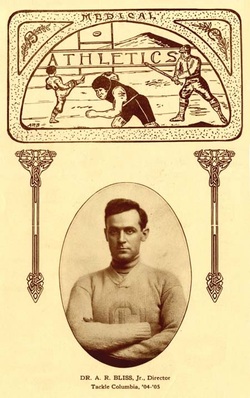 The Birmingham Medical College football
The Birmingham Medical College football team was coached by Dr. Richard Bliss Jr.
who had played his college ball at Columbia
University. (UAB Archives)
Pigskins to Stethoscopes: Football Players Who Practiced Medicine in Alabama
By Tim L. Pennycuff
On the surface, the two pursuits may not seem to have much in common, but in actuality, numerous collegiate football players have gone on to pursue careers in medicine. The two fields both require excellent discipline, time management, and work ethic; they may also spark other qualities of determination and tenacity. Regardless of which intersecting forces unite these pursuits, Alabama has benefitted from a number of football players-turned-physicians throughout the decades. Tim Pennycuff, an archivist at the University of Birmingham, has begun collecting a database of resources on such individuals, and in this article he shares some of the most compelling biographies from it.
About the Author
Tim L. Pennycuff is the University Archivist at the University of Alabama at Birmingham (UAB) where his faculty appointment is in UAB’s Lister Hill Library of the Health Sciences. He has been at UAB since 1993. He earned a bachelor’s degree from Tennessee Technological University and a master’s degree from the University of Alabama. Pennycuff has previously served as president of the Society of Alabama Archivists (SALA) and as chair of the Science, Technology and Healthcare Roundtable of the Society of American Archivists (SAA). He is currently a member of SALA, SAA, the Alabama Historical Association, and Archivists and Librarians in the History of Health Sciences. The subject of this contribution brings together his professional career as the university archivist at a major academic medical center and his love of collegiate football.
Additional InformationDo you know of a football player-physician with Alabama ties? The database is always growing, and we’d love to hear about people whose stories we have not yet encountered. To share a story, please complete the form at the UAB archives, available at http://www.uab.edu/archives/contact.
By Tim L. Pennycuff
On the surface, the two pursuits may not seem to have much in common, but in actuality, numerous collegiate football players have gone on to pursue careers in medicine. The two fields both require excellent discipline, time management, and work ethic; they may also spark other qualities of determination and tenacity. Regardless of which intersecting forces unite these pursuits, Alabama has benefitted from a number of football players-turned-physicians throughout the decades. Tim Pennycuff, an archivist at the University of Birmingham, has begun collecting a database of resources on such individuals, and in this article he shares some of the most compelling biographies from it.
About the Author
Tim L. Pennycuff is the University Archivist at the University of Alabama at Birmingham (UAB) where his faculty appointment is in UAB’s Lister Hill Library of the Health Sciences. He has been at UAB since 1993. He earned a bachelor’s degree from Tennessee Technological University and a master’s degree from the University of Alabama. Pennycuff has previously served as president of the Society of Alabama Archivists (SALA) and as chair of the Science, Technology and Healthcare Roundtable of the Society of American Archivists (SAA). He is currently a member of SALA, SAA, the Alabama Historical Association, and Archivists and Librarians in the History of Health Sciences. The subject of this contribution brings together his professional career as the university archivist at a major academic medical center and his love of collegiate football.
Additional InformationDo you know of a football player-physician with Alabama ties? The database is always growing, and we’d love to hear about people whose stories we have not yet encountered. To share a story, please complete the form at the UAB archives, available at http://www.uab.edu/archives/contact.
DEPARTMENT ABSTRACTS
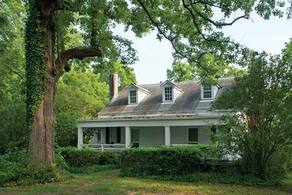 Family tradition holds that Ellerslie near Montgomery
Family tradition holds that Ellerslie near Montgomery incorporated building materials brought from
Georgia when its owner, Bolling Hall, relocated to
Alabama during territorial days. (Robin McDonald)
Southern Architecture and Preservation
Present at the Beginning
By Robert Gamble
As Alabama approaches its bicentennial, Robert Gamble reflects on the rich history the state has accumulated, and he considers the scarcity of structures remaining from the early nineteenth century. Huntsville’s Poplar Grove, which dates from 1814, is the state’s oldest confirmed structure, but the Alabama Historical Commission is working to identify and verify other possible structures that witnessed Alabama’s transformation from territory to state.
About the Author
Robert Gamble, standing editor of the “Southern Architecture and Preservation” department of Alabama Heritage, has recently retired as senior architectural historian for the Alabama Historical Commission. If any readers know of a building that may have been standing in 1819, please contact the author by email at [email protected].
Present at the Beginning
By Robert Gamble
As Alabama approaches its bicentennial, Robert Gamble reflects on the rich history the state has accumulated, and he considers the scarcity of structures remaining from the early nineteenth century. Huntsville’s Poplar Grove, which dates from 1814, is the state’s oldest confirmed structure, but the Alabama Historical Commission is working to identify and verify other possible structures that witnessed Alabama’s transformation from territory to state.
About the Author
Robert Gamble, standing editor of the “Southern Architecture and Preservation” department of Alabama Heritage, has recently retired as senior architectural historian for the Alabama Historical Commission. If any readers know of a building that may have been standing in 1819, please contact the author by email at [email protected].
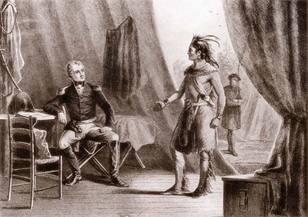 Not every Redstick leader was subject to Andrew
Not every Redstick leader was subject to AndrewJackson’s wrath. Following the Battle of
Horseshoe Bend, William Weatherford surrendered
to Jackson and persuaded other Redsticks to surrender.
In return, he was allowed to retire in peace and died
a wealthy planter in Monroe County in 1824.
(Library of Congress)
Becoming Alabama
Quarter By Quarter
By Joseph W. Pearson, Megan L. Bever, and Matthew L. Downs
Editor’s Note--Alabama Heritage, the Summersell Center for Study of the South, the University of Alabama Department of History, and the Alabama Tourism Department offer this department as a part of the statewide “Becoming Alabama” initiative—a cooperative venture of state organizations to commemorate Alabama’s experiences related to the Creek War, the Civil War, and the civil rights movement. Quarter by quarter we will take you to the corresponding seasons 200, 150, and 50 years ago—sometimes describing pivotal events, sometimes describing daily life, but always illuminating a world in flux. We will wait for the ultimate outcomes as our forebears did—over time. For those joining the story in progress, you can find earlier quarters on our website at www.AlabamaHeritage.com/BecomingAlabama.
This quarter’s installment of “Becoming Alabama” investigates the Treaty of Fort Jackson, which required Creek Indians to cede millions of acres of their ancestral lands; the Union assault on Mobile Bay; and the passage of the Civil Rights Act of 1964, which many southern congressmen opposed vehemently. Throughout, the authors show the ways that the past continues to shape Alabama’s present, and they trace the connections between the state’s history and its future.
About the Authors
Joseph W. Pearson is assistant professor of history at Union College. His dissertation, completed at the University of Alabama, explores the political culture of the American Whigs, specifically probing the shared underpinnings of their political thought and moral temper across class, gender, and section.
Megan L. Bever is assistant professor of history at Missouri Southern State University. Her dissertation, completed at the University of Alabama, explores alcohol, morality, and citizenship in the Civil War era.
Matthew L. Downs (PhD, Alabama) is an assistant professor of history at the University of Mobile. His dissertation focused on the federal government’s role in the economic development of the Tennessee Valley.
Quarter By Quarter
By Joseph W. Pearson, Megan L. Bever, and Matthew L. Downs
Editor’s Note--Alabama Heritage, the Summersell Center for Study of the South, the University of Alabama Department of History, and the Alabama Tourism Department offer this department as a part of the statewide “Becoming Alabama” initiative—a cooperative venture of state organizations to commemorate Alabama’s experiences related to the Creek War, the Civil War, and the civil rights movement. Quarter by quarter we will take you to the corresponding seasons 200, 150, and 50 years ago—sometimes describing pivotal events, sometimes describing daily life, but always illuminating a world in flux. We will wait for the ultimate outcomes as our forebears did—over time. For those joining the story in progress, you can find earlier quarters on our website at www.AlabamaHeritage.com/BecomingAlabama.
This quarter’s installment of “Becoming Alabama” investigates the Treaty of Fort Jackson, which required Creek Indians to cede millions of acres of their ancestral lands; the Union assault on Mobile Bay; and the passage of the Civil Rights Act of 1964, which many southern congressmen opposed vehemently. Throughout, the authors show the ways that the past continues to shape Alabama’s present, and they trace the connections between the state’s history and its future.
About the Authors
Joseph W. Pearson is assistant professor of history at Union College. His dissertation, completed at the University of Alabama, explores the political culture of the American Whigs, specifically probing the shared underpinnings of their political thought and moral temper across class, gender, and section.
Megan L. Bever is assistant professor of history at Missouri Southern State University. Her dissertation, completed at the University of Alabama, explores alcohol, morality, and citizenship in the Civil War era.
Matthew L. Downs (PhD, Alabama) is an assistant professor of history at the University of Mobile. His dissertation focused on the federal government’s role in the economic development of the Tennessee Valley.
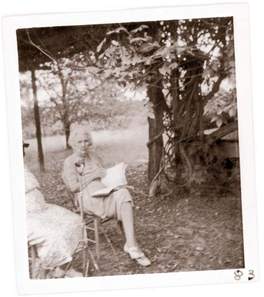 This photograph of Ruby Pickens Tartt in her
This photograph of Ruby Pickens Tartt in her garden in Livingston by Ruby Terrill Lomax
was taken on the John and Alan Lomax’s visit
to Sumter County in 1940.
Alabama Women
“Miss Ruby”: The Life and Career of Ruby Pickens Tartt
By Tina Naremore Jones
Even as a child, Ruby Pickens Tartt had a clear sense of her identity and her ambitions. An artist who studied in New York before returning to her native Alabama, Tartt remains best known for her contributions to the Works Progress Administration music archives. Working extensively with John Lomax, Tartt helped record and preserve numerous folk songs from across the state, and her work brought recognition to many of Alabama’s so-called outsider artists.
About the Author
Tina Naremore Jones is an English professor and dean of educational outreach at the University of West Alabama. Joshua D. Rothman, standing editor of the “Alabama Women” department of Alabama Heritage, is professor of history at the University of Alabama and director of the university’s Frances S. Summersell Center for the Study of the South, which sponsors this department.
Additional Information
For more information about Tartt and her varied professional pursuits, please see “Ruby Pickens Tartt: Citizen of the World,” by Philip D. Beidler and Elizabeth Buckalew, in Alabama Heritage 87.
“Miss Ruby”: The Life and Career of Ruby Pickens Tartt
By Tina Naremore Jones
Even as a child, Ruby Pickens Tartt had a clear sense of her identity and her ambitions. An artist who studied in New York before returning to her native Alabama, Tartt remains best known for her contributions to the Works Progress Administration music archives. Working extensively with John Lomax, Tartt helped record and preserve numerous folk songs from across the state, and her work brought recognition to many of Alabama’s so-called outsider artists.
About the Author
Tina Naremore Jones is an English professor and dean of educational outreach at the University of West Alabama. Joshua D. Rothman, standing editor of the “Alabama Women” department of Alabama Heritage, is professor of history at the University of Alabama and director of the university’s Frances S. Summersell Center for the Study of the South, which sponsors this department.
Additional Information
For more information about Tartt and her varied professional pursuits, please see “Ruby Pickens Tartt: Citizen of the World,” by Philip D. Beidler and Elizabeth Buckalew, in Alabama Heritage 87.
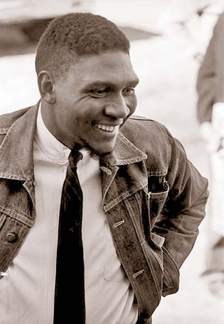 Richard Boone was an advocate of street
Richard Boone was an advocate of street protests. This photograph was taken at a
demonstration at Luverne, Alabama, in
1965. (ADAH)
Revealing Hidden Collections
Rev. Richard Charles Boone
By Howard O. Robinson
Each quarter, “Revealing Hidden Collections” highlights archival or library collections throughout the state, helping identify and celebrate some of Alabama’s lesser known resources. This quarter’s installment looks at the Alabama State University Boone Collection, which preserves materials connected to Rev. Richard Charles Boone, a field director for the Southern Christian Leadership Conference. The collection includes a range of materials, from letters and newspaper clippings to recordings of Boone’s speeches and even his “toilet paper manifesto,” a document he wrote while imprisoned. (He was later released for lack of evidence.) Each item helps contribute to visitors’ understanding of Boone and the cause for which he fought.
About the Author
Howard Robinson teaches American history at Alabama State University (ASU) and has served as the university archivist for ten years. He is a native of New York City, a graduate of ASU, and received his PhD in American history from the University of Akron. Louis A. Pitschmann, standing editor of the “Revealing Hidden Collections” department of Alabama Heritage, is Dean of the University Libraries at the University of Alabama and director of the Alabama Center for the Book, which co-sponsor this department.
Rev. Richard Charles Boone
By Howard O. Robinson
Each quarter, “Revealing Hidden Collections” highlights archival or library collections throughout the state, helping identify and celebrate some of Alabama’s lesser known resources. This quarter’s installment looks at the Alabama State University Boone Collection, which preserves materials connected to Rev. Richard Charles Boone, a field director for the Southern Christian Leadership Conference. The collection includes a range of materials, from letters and newspaper clippings to recordings of Boone’s speeches and even his “toilet paper manifesto,” a document he wrote while imprisoned. (He was later released for lack of evidence.) Each item helps contribute to visitors’ understanding of Boone and the cause for which he fought.
About the Author
Howard Robinson teaches American history at Alabama State University (ASU) and has served as the university archivist for ten years. He is a native of New York City, a graduate of ASU, and received his PhD in American history from the University of Akron. Louis A. Pitschmann, standing editor of the “Revealing Hidden Collections” department of Alabama Heritage, is Dean of the University Libraries at the University of Alabama and director of the Alabama Center for the Book, which co-sponsor this department.
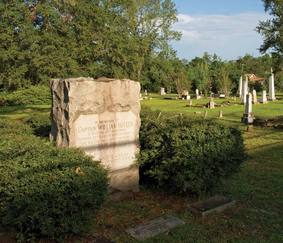 Capt. William Butler and two companions were
Capt. William Butler and two companions were brutally murdered by Savannah Jack on March
20, 1818. Two decades later, their remains where
reinterred in Pioneer Cemetery in Greenville,
county seat of the county named for
Captain Butler. (Robin McDonald)
Portraits and Landscapes
The Legend of Savannah Jack
By Mollie Smith Waters
One of the most storied villains and murders in Alabama’s history remains largely a mystery to historians, who do not know his ancestry, his background, or even his appearance. What they do know, however, is that in the years immediately before Alabama’s statehood, Savannah Jack terrorized newly arriving white settlers, often murdering them and their families. Mollie Waters offers an overview of this rebel who haunted the Alabama territory and struck fear in its inhabitants.
About the Author
Mollie Smith Waters is an instructor of the humanities at Lurleen B. Wallace Community College.
The Legend of Savannah Jack
By Mollie Smith Waters
One of the most storied villains and murders in Alabama’s history remains largely a mystery to historians, who do not know his ancestry, his background, or even his appearance. What they do know, however, is that in the years immediately before Alabama’s statehood, Savannah Jack terrorized newly arriving white settlers, often murdering them and their families. Mollie Waters offers an overview of this rebel who haunted the Alabama territory and struck fear in its inhabitants.
About the Author
Mollie Smith Waters is an instructor of the humanities at Lurleen B. Wallace Community College.
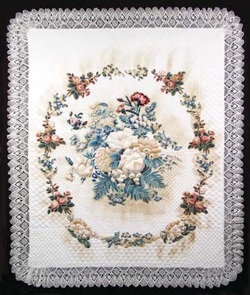 The newly conserved Baby Quilt was
The newly conserved Baby Quilt was made prior to 1862 and hangs in the
upstairs hall of the First White House
of the Confederacy in Montgomery,
Alabama. (Kathryn S. Tarleton, ConText Inc.)
Alabama Treasures
The Tale of Two Quilts
When most people think of Civil War artifacts, often they consider items such as weapons, uniforms, flags, or letters. However, some important artifacts may have never seen a battlefield. One example is the Gunboat Quilt, an item in the collection of the First White House of the Confederacy, which was produced to help raise funds to buy Confederate gunboat to help protect Mobile Bay. They quilt’s 150 years have taken a toll on it, and conservation has proved tricky—but crucial. Officials from the White House of the Confederacy detail the recent steps taken to preserve this part of Alabama’s history.
About the Author
Anne Henry Tidmore, who graduated from Huntingdon College with a BA in English and history, became the Regent for the White House Association of Alabama in 2009, the organization formed in 1900 to save the First White House of the Confederacy in Montgomery. She writes a blog and is in the process of writing a book about the First White House of the Confederacy. She began Tidmore Flags, a retail and mail order flag business in Birmingham in 1964 and retired in 2001.
Additional Information
The origin of the Gunboat Quilt and the Baby Quilt at the First White House of the Confederacy is a mystery. Historians know they were made by the same person, but the question lingers about who this person actually was. Martha Jane Hatter, who later married widower Colonel Bullock, claims to have been the maker, but the descendants of Colonel Bullock are convinced that they were made by Panthea Bullock, Colonel Bullock’s first wife and mother of his children. This is yet another intriguing story concerning the two quilts at the First White House.
The newly conserved Gunboat Quilt from the First White House of the Confederacy will be at the New York Historical Society exhibit in New York City from April 4, 2014–August 31, 2014; at the Shelburne Museum in Shelburne, Vermont, from September 20–January 1, 2015; and at the Nebraska State Historical Society in Lincoln, Nebraska, from February 1, 2015–June 30, 2015.
For more information about Gunboat Quilts, see the Alabama Heritage, Issue 8, Spring 1988, article by Bryding Adams Henley.
The Tale of Two Quilts
When most people think of Civil War artifacts, often they consider items such as weapons, uniforms, flags, or letters. However, some important artifacts may have never seen a battlefield. One example is the Gunboat Quilt, an item in the collection of the First White House of the Confederacy, which was produced to help raise funds to buy Confederate gunboat to help protect Mobile Bay. They quilt’s 150 years have taken a toll on it, and conservation has proved tricky—but crucial. Officials from the White House of the Confederacy detail the recent steps taken to preserve this part of Alabama’s history.
About the Author
Anne Henry Tidmore, who graduated from Huntingdon College with a BA in English and history, became the Regent for the White House Association of Alabama in 2009, the organization formed in 1900 to save the First White House of the Confederacy in Montgomery. She writes a blog and is in the process of writing a book about the First White House of the Confederacy. She began Tidmore Flags, a retail and mail order flag business in Birmingham in 1964 and retired in 2001.
Additional Information
The origin of the Gunboat Quilt and the Baby Quilt at the First White House of the Confederacy is a mystery. Historians know they were made by the same person, but the question lingers about who this person actually was. Martha Jane Hatter, who later married widower Colonel Bullock, claims to have been the maker, but the descendants of Colonel Bullock are convinced that they were made by Panthea Bullock, Colonel Bullock’s first wife and mother of his children. This is yet another intriguing story concerning the two quilts at the First White House.
The newly conserved Gunboat Quilt from the First White House of the Confederacy will be at the New York Historical Society exhibit in New York City from April 4, 2014–August 31, 2014; at the Shelburne Museum in Shelburne, Vermont, from September 20–January 1, 2015; and at the Nebraska State Historical Society in Lincoln, Nebraska, from February 1, 2015–June 30, 2015.
For more information about Gunboat Quilts, see the Alabama Heritage, Issue 8, Spring 1988, article by Bryding Adams Henley.
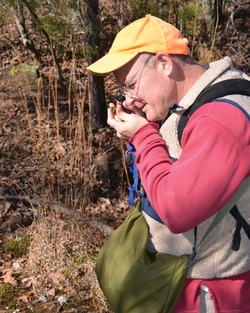 Paul Davison at Northfork Creek, Marion County,
Paul Davison at Northfork Creek, Marion County, peers through a hand lens at something very,
very small. (L. J. Davenport)
Nature Journal
The Small World of Northfork Creek
By L. J. Davenport
When the 2011 tornadoes hit Alabama, many aspects of the natural world were disrupted.
Although Northfork Creek, near Hackleburg, bears signs of the storm still, the ecosystem also possesses many compelling examples of “micro” life—including Frullania, a kind of liverwort. Davenport describes the quest to find this plant life, and in the process he offers a celebration of all things small.
About the Author
Larry Davenport is a professor of biology at Samford University, Birmingham, Alabama.
The Small World of Northfork Creek
By L. J. Davenport
When the 2011 tornadoes hit Alabama, many aspects of the natural world were disrupted.
Although Northfork Creek, near Hackleburg, bears signs of the storm still, the ecosystem also possesses many compelling examples of “micro” life—including Frullania, a kind of liverwort. Davenport describes the quest to find this plant life, and in the process he offers a celebration of all things small.
About the Author
Larry Davenport is a professor of biology at Samford University, Birmingham, Alabama.
Reading the Southern Past
Populists and Progressives, Democrats and Republicans
By Stephen Goldfarb
This quarter, Stephen Goldfarb reviews books that look at the South’s changing political landscape. He considers The Irony of the Solid South: Democrats, Republicans, and Race, 1865–1944 (University of Alabama Press, 2013) by Glenn Feldman and Populism to Progressivism in Alabama (first published in 1969 by Princeton University Press and now available as part of the The Library of Alabama Classics published by University of Alabama Press) by Sheldon Hackney. Taken together, these texts offer a historical approach to several different periods of political change throughout Alabama.
About the Author
Stephen Goldfarb holds a PhD in the history of science and technology. He retired from a public library in 2003.
Populists and Progressives, Democrats and Republicans
By Stephen Goldfarb
This quarter, Stephen Goldfarb reviews books that look at the South’s changing political landscape. He considers The Irony of the Solid South: Democrats, Republicans, and Race, 1865–1944 (University of Alabama Press, 2013) by Glenn Feldman and Populism to Progressivism in Alabama (first published in 1969 by Princeton University Press and now available as part of the The Library of Alabama Classics published by University of Alabama Press) by Sheldon Hackney. Taken together, these texts offer a historical approach to several different periods of political change throughout Alabama.
About the Author
Stephen Goldfarb holds a PhD in the history of science and technology. He retired from a public library in 2003.
